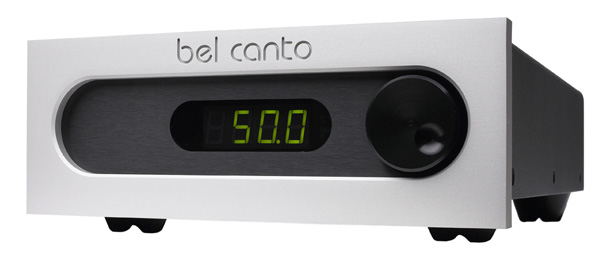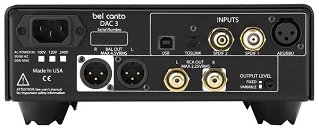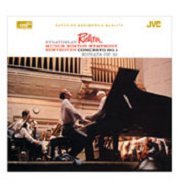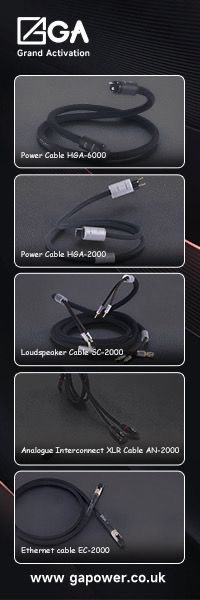Bel Canto DAC3
| Bel Canto DAC3 |
| Digital at its finest |
|
|
|
April 2007 |

My relationship with Bel Canto began years ago when I read a glowing review of their DAC1 on a web site. At the time I was using a Parasound D/AC-1100 and I was intrigued by Bel Canto’s little black box (a fraction of the size and weight of the Parasound) that used the latest chips and held the promise of significantly improved sound. I bought a DAC1 on the basis of that review and used it first with a Parasound (CEC) CBD-2000 belt drive transport, and later with a PS Audio Lambda (which was built around the superb Philips CDM9 Pro transport mechanism – featuring a glass lens). The Bel Canto DAC2 appeared a year or two later, looked exactly the same as the DAC1, and again I bought one. But the DAC2 didn’t seem to get along with the Lambda. Every now and then the signal light on the DAC would go from green to red, with a corresponding dead silence. During a lengthy telephonic correspondence with Bel Canto about this problem, I eventually put an oscilloscope on the S/PDIF output of the Lambda and discovered an intermittent instability in its clock, to which the receiver chip of the DAC1 had not been sensitive, but which caused the receiver chip of the DAC2 to shut down. I still had the DAC1, but I felt the sonic improvement of the DAC2, while not staggering, was enough to warrant the purchase of a replacement transport. I took a dive off the deep end and bought a used Accuphase DP90 which got along just fine with the DAC2. And so the two of them have gone along now for several years – the DP90 and the DAC2 – making some pretty glorious music.
During the time of my DAC2/Lambda tribulation, I was advised and befriended by Jay Tonkinson, who is a key member of Bel Canto’s design team lead by John Stronczer. Tonkinson is responsible for the design and layout of the printed circuit boards of the DAC1, DAC2 and DAC3, as well as other Bel Canto products. Back then we’d speculated on the potential of the chips, how a subsequent version might be packaged, what controls and functions it might have, and so forth. Time passed. I called Tonkinson some months ago to ask what’s new. And he told me: what’s new is the Bel Canto DAC3.
Tonkinson spoke very highly of the new DAC. A long time admirer of the ‘analog sound’ of vinyl, he said that the DAC3 had finally achieved that elusive quality. I knew right away that trouble was a-brewing, that the status quo of my digital front end was likely to change again, and pretty soon. I requested a review sample of the DAC3. A number of weeks later it arrived and it looked nothing like its predecessors. No longer a plain black rectangle, but a thoughtful and elegant design with multiple inputs and outputs, a single control knob (power, volume and input selection) along side a green LED display, remote capability, and a level of engineering that, typical of Bel Canto, is very impressive. And like the DAC2, it’s got the brain power of a small computer (in fact, when you power it on, “r 1.06” is displayed – the revision level of the firmware).
The unit had been in the hands of a previous reviewer and was presumably burnt in, so I allowed it a few hours to stabilize and began playing music. The very first thing I noticed, with the DAC3 directly driving my amplifier’s unbalanced inputs, was a sense of greater silence from which the music emerged. Of course the noise levels of the DAC3, as well as the DAC1 and DAC2, are inaudible. And I suspect that what I was not hearing is what reviewers sometimes elusively refer to as a “blacker background.” The second thing I noticed was a truly mind-boggling sense of presence. Presence in a wholly different league than the improvement of the DAC2 over the DAC1. And the third thing I noticed was the emergence of sonic details I’d not suspected were present. The retrieval of heretofore obscured detail could be perceived or interpreted as a “blacker” background. I continue to be amazed at the fine nuances of sound the DAC3 retrieves, such as the resonance of a violin cavity continuing to sound after the bow has stopped. This is unquestionably and by a wide margin the best sound I’d ever heard on my stereo. No other change in equipment, except the change in loudspeakers from KEF101s to Newform Research R645s, had improved the experience of music listening to this degree.
Now, I do not have an acoustically ideal listening room, few of us do; nor do I own the best loudspeakers I’ve ever heard. (In fairness to Newform Research I should add that one would be hard pressed to find a loudspeaker for under $2300 – which is what I paid five years ago – that equals the R645, and few at any price to match it from 1000Hz up, the crossover point of the ribbons). But even with these disadvantages in play, the illusion of realism, the palpability of soundstage and image, the tonal richness and the absence of coloration, were very impressive. Perhaps the best endorsement of this DAC I can give is that within minutes of first hearing it, literally minutes, I went to my computer, logged on to Audigon, and sold my DAC2. And there was a small frenzy of activity right away: the DAC2 has a terrific reputation.
The logic of the DAC3 builds on that of the DAC2, but goes much further. All digital inputs are galvanically isolated with shielded, wide-bandwidth transformers. Such pricey transformers are, to say the least, not commonplace in the world of nonprofessional audio. In all the years I’ve followed audiophile equipment reviews, I’ve encountered only one device – a very costly preamplifier – employing input transformers. The USB input also has a transformer, effectively isolating the receiver chip from the typically very noisy environment of computers. The phase locked loop (PLL) at this stage provides jitter levels of 200pS.
Following the digital audio receiver is an Asynchronous Sample Rate Converter (ASRC) that converts digital inputs ranging from 16/44.1 to 24/96 to the final 24 bit, 192KHz rate for conversion to analog. Increasing the bit depth has the theoretical advantage of reducing quantization noise. Increasing sample rate enables the use of slow roll-off linear phase analog and digital filters at 100KHz, as were used in the DAC2. A gentle filter at this frequency reduces phase shift and provides a more natural sounding harmonic structure. Upsampling to 24 bits also enables the use of an internal volume control in the digital realm. Jitter beyond the ASRC stage is virtually eliminated. The DAC3 white paper states: “Our measurements show that this second PLL stage [in the ASRC] prevents even high levels of jitter (10 nanoseconds P-P at 10KHz) from corrupting the analog output of the DAC3.” This is to say, jitter levels as high as 10,000pS (!) at this point would be undetectable at the analog output.
The actual digital to analog converter chip is a Texas Instruments PCM1792A providing 130db of dynamic range. (This chip is said to provide the advantages of both multi-bit and sigma-delta conversion: feel free to look these up in Ken Pohlmann’s Principles of Digital Audio. And good luck.) The current-based analog output of this chip is converted to voltage (I/V) using transistors with a 90MHz bandwidth in a folded cascode architecture to provide the lowest possible noise and distortion. Further performance advantages come from the Class A biasing of the analog output section. All electronics components in the analog section are run in true Class A bias mode, including the critical signal resistors.
The DAC3 uses a master clock of unprecedented accuracy and stability. Frequency accuracy is rated at 0.0001% and jitter at 1pS RMS (5pS P-P). The white paper states this is “…50 to 100 times better than the best alternative clock devices.” The importance of clock accuracy and freedom from jitter in digital to analog conversion cannot be overstated: the Ultra-Clock™ can be said to be the heart of the DAC3. The DAC3 remains in standby even when the power is turned off, maintaining a stable temperature that contributes to clock stability.
Circuit board construction and layout in the DAC3, component choices, even the use of silver-bearing eutectic solder, are all carefully engineered and subjected to listening tests as well as measurement. The white paper goes on to state: “The single largest and most critical passive device in any circuit design is the PC board.” I find it very impressive that Bel Canto put so much time, money and effort into this aspect of the DAC3 design. Multiple ground and power planes in a 4-layer PC board provide optimal isolation, low noise, the multiple layers of the board itself acting as a decoupling capacitor. The use of large scale ICs enables the PC board to be quite compact, further reducing noise levels and shortening signal paths.
The master-stroke of the Bel Canto DAC3 design is the digital volume control which covers 100db in 0.5db steps. This allows bypassing a preamplifier altogether. Definitely an instance of less is more: the DAC3 sounds its best directly driving an amplifier, and Bel Canto say it is at its very best directly driving an amplifier using XLR (balanced) cables. For purposes of this review, I constructed balanced cables using Neutrik gold-plated XLR connectors and Belden 1800F cable. The DAC3’s balanced output, incidentally, provides 6db gain over its unbalanced output; minus a 3db increase in the noise floor, resulting in a 3db overall gain. Other than the slight change in gain, I felt balanced cables may provide somewhat richer, fuller harmonics. In any case, Bel Canto – like every other manufacturer that provides them – recommends using XLR connectors, which are less prone to RFI contamination and free of DC offsets.
Of the many difficult concepts and characteristics of digital audio,dither is one of the most non-intuitive. Every CD on your shelf is dithered during the recording process. I cannot claim to understand how it works, but I’ve seen the math, and it does work: information encoded in the LSBs (least significant bits) of a given word length can be encoded, and retrieved, in a word of shorter length. Dither can be thought of as very low level white noise of a specific power spectrum that is added to a digital signal. Dither not only enables the encoding of data below the LSB of a given word length, it also masks quantization noise. And the ear is capable of hearing encoded data even though it may fall below the noise floor of the signal. The DAC3 redithers digital data, employing chips that are essentially powerful CPUs in their own right, operating well above 24 bit word lengths, continuously generating dither values. Now, given that a single bit represents 6db, reducing the volume level in the digital realm by 6db involves shortening word length by one bit. This is almost certainly implemented not by altering actual word length, but by a logical shift of all data one bit to the right, toward the LSB. In order that the LSB not be simply truncated, the word must be redithered to the reduced length. While setting the volume control to very low levels does reduce the effective bit depth the noise floor remains ‘white’ and clean with no digital nastiness heard. Full 16 bit resolution is available over 48dB of control range (52.0 on the front panel display, a setting that is far below normal listening levels). The noise floor of the DAC3 is extremely low, lower than most analog preamplifiers.
Peter Walker, who designed the original Quad loudspeaker, once compared the volume control of a preamplifier to the focus control of a camera. I would suggest a corollary to this, that the more accurate the recording/reproduction, the more this phenomenon is evident. And it has never been so evident, nor so critical, as with the DAC3: at the correct volume level, the image snaps into focus, although I’d suggest a modified term like “spatial focus,” three-dimensional locus in a specific venue. It’s almost uncanny. I found that a change of as little as 0.5db can make a difference in spatial focus. Now, half a decibel represents a difference in loudness that in itself is not absolutely detectable by most people, myself included, but can be revealing in terms of image specificity. Non-audiophile visitors who normally would not have, stopped, listened, and commented on the realism of the sound. It’s always bracing to have someone say, It sounds like a real piano. Of course, it does not, but the Bel Canto DAC3 makes the illusion that much more convincing.
 The digital volume control of the DAC3 can be bypassed with a push button switch on the rear of the unit. Ingeniously, the level of the fixed output can be set by first adjusting the volume, then pushing the switch. Using a fixed output level allows one to drive a separate preamplifer and use itsvolume control(s). This setup has the advantage of a single “control center” for various sources, CD, vinyl, tuner, and computer, without having to juggle cables. It has the disadvantage of not sounding as good, even when using a relatively neutral preamp like the Audible Illusions Modulus 3A (with line stage Russian 6H23s only a couple of months old, that is to say, broken in but still at peak performance). The preamp seems to “blend” the instrumental textures somewhat, creating a rich and gorgeous, but less demarcated, sound stage and image. My power amplifier has switch-selectable inputs, so my solution to using both digital and analog sources was to connect my amplifier’s unbalanced inputs to the preamp, and its balanced inputs to the DAC3. When I want to listen to records or to the tuner, I have only to power up the Modulus and flip a pair of switches on the back of the amplifier.
The digital volume control of the DAC3 can be bypassed with a push button switch on the rear of the unit. Ingeniously, the level of the fixed output can be set by first adjusting the volume, then pushing the switch. Using a fixed output level allows one to drive a separate preamplifer and use itsvolume control(s). This setup has the advantage of a single “control center” for various sources, CD, vinyl, tuner, and computer, without having to juggle cables. It has the disadvantage of not sounding as good, even when using a relatively neutral preamp like the Audible Illusions Modulus 3A (with line stage Russian 6H23s only a couple of months old, that is to say, broken in but still at peak performance). The preamp seems to “blend” the instrumental textures somewhat, creating a rich and gorgeous, but less demarcated, sound stage and image. My power amplifier has switch-selectable inputs, so my solution to using both digital and analog sources was to connect my amplifier’s unbalanced inputs to the preamp, and its balanced inputs to the DAC3. When I want to listen to records or to the tuner, I have only to power up the Modulus and flip a pair of switches on the back of the amplifier.
The USB port of the DAC3 has a maximum input capacity of 16 bits at 48,000 Hz. Intrigued by reports of the superior sound of hard disc digital sources, sources free of jitter and free of error correction? With the USB port, you can use a computer as a source of (uncompressed) digital data and obviate the necessity of a dedicated CD transport. Tonkinson uses an Mac “Mini” computer running iTunes and he says it’s the best sound he’s ever had.
 It’s been a long time since I’ve listened to a single disc as continually over many months as the Alban Berg Quartet’s recording of Beethoven’s Opus 127 in E-flat (EMI Classics 5 73606 2). (Officially, the E-flat is not on a par with the succeeding three Late Quartets; unofficially, it’s my favorite.) The DAC2 also beautifully reproduces the tonality and sonority of these recordings, also captures the intensity, the titanic shifts of mood and the otherworldly wisdom of this music, but where the DAC3 excels is in presentation and detail. This was the first CD I listened to through the DAC3, and I was nothing short of astonished. The lateral positioning of the instruments is more defined. Nuances of bowing and attack are clearer. But it is the front to back positioning of the players that really grants an enhanced sense of reality. Not only can you clearly picture the instruments behind the physical location of the loudspeakers, you can clearly hear (feel) the venue boundaries, the physical space around the musicians. (This is also evident on top quality jazz recordings, like Clifford Jordan’s Live At Ethell’s on Mapleshade. Never before has this live club recording sounded so real.) Beethoven’s Late quartets are quite unlike anything else in Western music, they are profoundly intimate and even life changing; the pure sound itself is like nothing else in the literature. The opening tutti chords of the Maestoso are like a joyous cry of all Creation. And Bel Canto’s DAC3 – and the extraordinary musicianship of the Alban Berg Quartet – present the astute listener with a transcendental experience.
It’s been a long time since I’ve listened to a single disc as continually over many months as the Alban Berg Quartet’s recording of Beethoven’s Opus 127 in E-flat (EMI Classics 5 73606 2). (Officially, the E-flat is not on a par with the succeeding three Late Quartets; unofficially, it’s my favorite.) The DAC2 also beautifully reproduces the tonality and sonority of these recordings, also captures the intensity, the titanic shifts of mood and the otherworldly wisdom of this music, but where the DAC3 excels is in presentation and detail. This was the first CD I listened to through the DAC3, and I was nothing short of astonished. The lateral positioning of the instruments is more defined. Nuances of bowing and attack are clearer. But it is the front to back positioning of the players that really grants an enhanced sense of reality. Not only can you clearly picture the instruments behind the physical location of the loudspeakers, you can clearly hear (feel) the venue boundaries, the physical space around the musicians. (This is also evident on top quality jazz recordings, like Clifford Jordan’s Live At Ethell’s on Mapleshade. Never before has this live club recording sounded so real.) Beethoven’s Late quartets are quite unlike anything else in Western music, they are profoundly intimate and even life changing; the pure sound itself is like nothing else in the literature. The opening tutti chords of the Maestoso are like a joyous cry of all Creation. And Bel Canto’s DAC3 – and the extraordinary musicianship of the Alban Berg Quartet – present the astute listener with a transcendental experience.
Large-scale music, especially music employing a choir in addition to an orchestra, is probably the most difficult type to reproduce in my small living room, plagued as it is with imperfect proportions, a suspended wooden floor, a typical eight foot ceiling, a large picture window behind a drapery, untreatable reflective surfaces (like a brick-surrounded wood burning stove), financially limited acoustical treatments, and a fair amount of ambient noise (including the incessant barking of the neurotic white dog across the street). I chose Robert Spano’s Grammy-winning recording of Berlioz’s Requiem with the Atlanta Symphony and Chorus (Telarc hybrid, SACD-60627). Telarc records exclusively in DSD format, then converts to PCM for the CD layer of their hybrid SACDs. The perfectly reasonable argument that the PCM layer really should be independently encoded and recorded, and the additional stage of conversion avoided, is silenced by the sonic quality of their discs, among the best I’ve ever heard. This is a monumental piece of music. Years after its premier Berlioz wrote that, If I were threatened with the destruction of everything I have created except for one work, I would beg mercy for the Requiem.I’ve heard this disc any number of times through the DAC2, but never before did I get goose bumps. No requiem I know of is so haunted by death and the hope of resurrection. The DAC3 provides that elusive quality that I’ve attempted to describe, but that always boils down to a greater sense of realism. The male choir almost whispering Kyrie eleison (a transliteration of the Greek, Lord have mercy, that is probably pre-Christian in origin), the shattering proclamation of Dies irae by the brass, the full choir and horns declaring Rex tremendae – I could go on – are among the most thrilling experiences in all of Western music. This is not the calm Lutheran faith of J.S. Bach, this is the terror and the pious hope of the Catholic vision one finds in Medieval paintings (the album cover is appropriate). One feels, ultimately, privileged to have such an intense aesthetic experience…in one’s own living room.
I chose Robert Spano’s Grammy-winning recording of Berlioz’s Requiem with the Atlanta Symphony and Chorus (Telarc hybrid, SACD-60627). Telarc records exclusively in DSD format, then converts to PCM for the CD layer of their hybrid SACDs. The perfectly reasonable argument that the PCM layer really should be independently encoded and recorded, and the additional stage of conversion avoided, is silenced by the sonic quality of their discs, among the best I’ve ever heard. This is a monumental piece of music. Years after its premier Berlioz wrote that, If I were threatened with the destruction of everything I have created except for one work, I would beg mercy for the Requiem.I’ve heard this disc any number of times through the DAC2, but never before did I get goose bumps. No requiem I know of is so haunted by death and the hope of resurrection. The DAC3 provides that elusive quality that I’ve attempted to describe, but that always boils down to a greater sense of realism. The male choir almost whispering Kyrie eleison (a transliteration of the Greek, Lord have mercy, that is probably pre-Christian in origin), the shattering proclamation of Dies irae by the brass, the full choir and horns declaring Rex tremendae – I could go on – are among the most thrilling experiences in all of Western music. This is not the calm Lutheran faith of J.S. Bach, this is the terror and the pious hope of the Catholic vision one finds in Medieval paintings (the album cover is appropriate). One feels, ultimately, privileged to have such an intense aesthetic experience…in one’s own living room.
 Richter chose Beethoven’s Sonata No. 22, Opus 54 to fill out RCA’s LP issue of the first piano concerto back in 1962. For me Richter’s performance of this two-movement sonata remains without peer. The sonata itself continues to be controversial. Is it a great work or a mediocre work? One well-known pianist suggested Opus 54 is some sort of spoof on how a bad piano sonata is written; I am one of the apparent minority who disagree and hold Opus 54 in highest esteem. Now, it’s been a long time since I’ve sat down at a piano, nonetheless this recording has always struck me as capturing to a unique degree the soul of that instrument. And what a marvel is JVC’s meticulous XRCD reissue (JM-XR24018). For me, listening to reproduced music has always been a matter of the suspension of disbelief. This is as true today as it was when Caruso recorded on Edison wax cylinders. On hearing that miracle of sound reproduction at the turn of the 20th Century the commonplace response was, It sounds just like live music! Better equipment, better recordings, simply make the process of suspending disbelief easier. And as good as this disc has always sounded, the DAC3 betters my past experience and creates that magical transformation of living room to recording studio with ease and aplomb. Once again, it seems to be the presentation of heretofore missing nuances of sound that makes the difference.
Richter chose Beethoven’s Sonata No. 22, Opus 54 to fill out RCA’s LP issue of the first piano concerto back in 1962. For me Richter’s performance of this two-movement sonata remains without peer. The sonata itself continues to be controversial. Is it a great work or a mediocre work? One well-known pianist suggested Opus 54 is some sort of spoof on how a bad piano sonata is written; I am one of the apparent minority who disagree and hold Opus 54 in highest esteem. Now, it’s been a long time since I’ve sat down at a piano, nonetheless this recording has always struck me as capturing to a unique degree the soul of that instrument. And what a marvel is JVC’s meticulous XRCD reissue (JM-XR24018). For me, listening to reproduced music has always been a matter of the suspension of disbelief. This is as true today as it was when Caruso recorded on Edison wax cylinders. On hearing that miracle of sound reproduction at the turn of the 20th Century the commonplace response was, It sounds just like live music! Better equipment, better recordings, simply make the process of suspending disbelief easier. And as good as this disc has always sounded, the DAC3 betters my past experience and creates that magical transformation of living room to recording studio with ease and aplomb. Once again, it seems to be the presentation of heretofore missing nuances of sound that makes the difference.
With the release of the DAC3, Bel Canto has taken a giant step toward realizing the full potential of CD sound reproduction; a potential that, for all we know, may not have been fully achieved yet, but with the DAC3 far exceeds anything I’ve heard before. Bel Canto’s meticulous attention to detail and sonic purity has resulted in their finest DAC yet.
Russell Lichter
____________________
Bel Canto DAC3 Specifications
Digital Inputs:
16/32 to 24/96 Input: AES 110ohm XLR, S/PDIF 75ohm BNC and RCA, TOSLINK; 16/32 to 16/48 Input: USB
Analog Otputs:
Balanced (XLR): 4.5V, 200 ohms
Unbalanced (RCA): 2.25V, 500 ohms
Frequency Response: 20Hz-20kHz, +/- 0.5dB
Dynamic Range: 129 dB balanced, 126 dB single ended
THD+N: <0.0015%, balanced, 1KHz
IMD (CCIF): <0.0005%, 19:20KHz, 4 ohms
Output Noise: 3uVrms A-weighted 20Hz-20KHz
Channel Separation: >110db
Master Clock Jitter: 1pS RMS, 5pS P-P
Weight & Measurements
Dimensions: 8.5” W x 12.5” D x 3” H
Net weight: 14lbs
Price: $2,495
Bel Canto Design, Ltd.
221 North 1st Street
Minneapolis MN 55401
USA
Website: www.belcantodesign.com
Tel: 612-317-4550 (9AM CST to 5 PM CST M-F)
Toll-free (866) 200-7342
Fax: 612-359-9358
![]()
Don’t forget to bookmark us! (CTRL-SHFT-D)
Stereo Times Masthead
Publisher/Founder
Clement Perry
Editor
Dave Thomas
Senior Editors
Frank Alles, Mike Girardi, Russell Lichter, Terry London, Moreno Mitchell, Paul Szabady, Bill Wells, Mike Wright, and Stephen Yan,
Current Contributors
David Abramson, Tim Barrall, Dave Allison, Ron Cook, Lewis Dardick, John Hoffman, Dan Secula, Don Shaulis, Greg Simmons, Eric Teh, Greg Voth, Richard Willie, Ed Van Winkle, Rob Dockery, Richard Doron, and Daveed Turek
Site Management Clement Perry
Ad Designer: Martin Perry





Be the first to comment on: Bel Canto DAC3